| August 2021 | | | Change is upon us again with the latest COVID lockdowns. As an essential service, we are here for you and your animals. We are not having clients in the building to manage risks. Please bear with us during this trying time.
August is dental month here at OVH- for all animals large and small! Our Large Animal newsletter detailed the importance of equine dentals, and this newsletter probes the importance of dental care (preventative and treatment) for our smaller and pocket pets.
To check your pet's teeth at home, have a look at the link below to our short piece on YouTube. | | | How to check your pet's teeth |
|
|
Dental joke
Why is a toothless dog like a tree?
It has more bark than bite! |
|
|
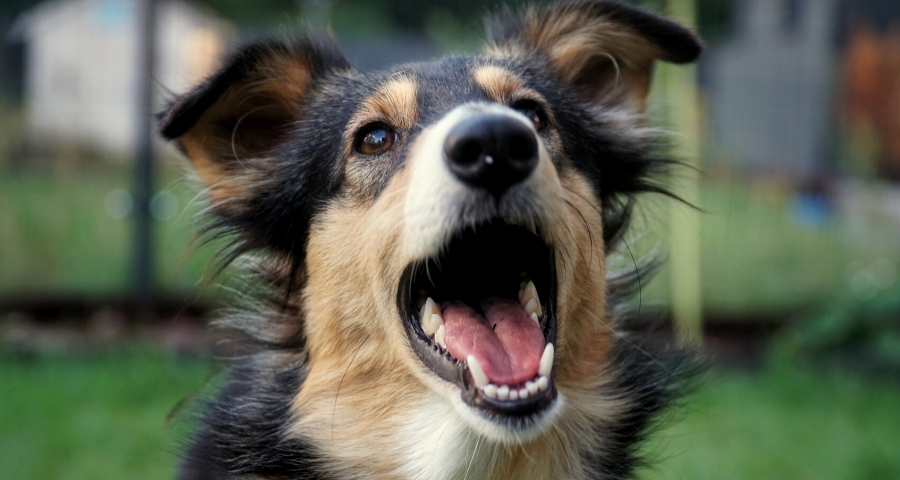 | | My pet’s teeth don’t look right | | | Dental disease doesn’t just involve plaque and periodontal disease! Quite commonly, pets present to us with missing, fractured or damaged teeth. Many of these dental issues can cause problems for your dog, rabbit, horse or cat, and are therefore best diagnosed and treated promptly.
Missing teeth!
Older animals may commonly be missing some teeth due to previous extractions or dental disease. We prefer not to leave diseased teeth to “fall out on their own”, as this often means a lot of discomfort for your pet in the meantime, just like if you have a sore tooth and tooth ache, as well as being a potential for infection. Sometimes tooth infections can cause serious problems, including abscesses behind the eye, or weight loss.
Another common reason for missing teeth is the usual “teething” process in young animals, where the temporary baby teeth make way for stronger adult teeth. This generally happens between about four-to-six months old. As your pet grows, your vet will check the teeth and make recommendations accordingly.
Teeth can also be absent in young animals due to either being unformed or retained. Unformed teeth are simply teeth that just aren’t there! Generally, this doesn’t cause an issue, but we can x-ray the mouth to check. Retained teeth are any of the pet's baby teeth that remain in the jaw and haven't been dislodged by the adult teeth growing through. Unfortunately, these retained teeth can promote dental disease and even develop cysts around them, which can lead to secondary issues. If your pet has two of the same type of tooth present at any one time, we recommend extraction of the baby tooth.
What causes damaged teeth?
The two most common reasons for damaged teeth are broken teeth due to injury or trauma, or teeth with resorptive lesions. Trauma can be self inflicted, like running into a wall at speed chasing a ball, or from another pet or larger object like after a car accident. Resorptive lesions are similar to cavities, and are especially common in cats- more on this next newsletter.
Damaged teeth are generally painful and can become infected, and therefore are best extracted by one of our vets. We can arrange referral to a veterinary dental specialist if you would like a specialist appointment- just let us know. Generally, this requires a trip to Sydney, which has proved problematic in recent COVID-19 times.
Whilst we do examine your pet’s teeth at their annual check-up, it’s a great idea for you to also regularly check them at home, looking for any changes in appearance.
If you’re unsure after looking at your pet's teeth (see video link below), have a chat with our team for further advice! |
|
|
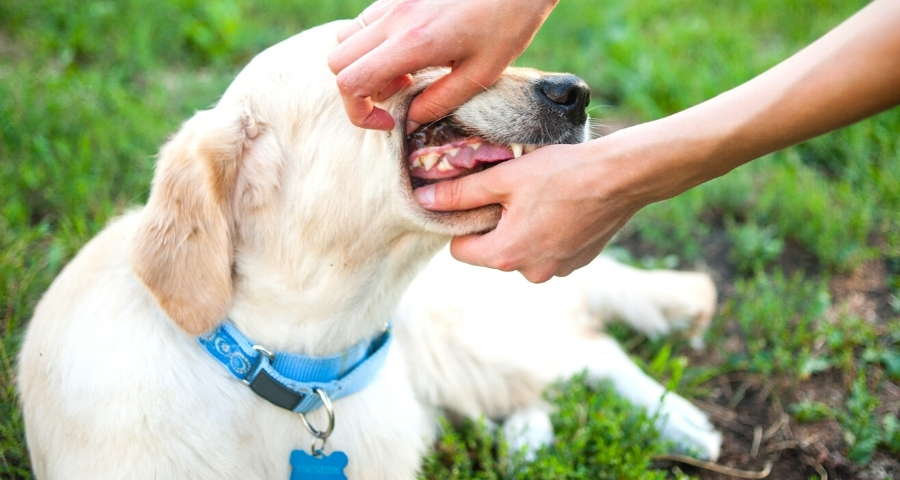 | | Crowded mouth | | | Did you know that just like us, cats, dogs and even rabbits and guinea pigs, can have crooked or crowded teeth? Here are a few common troublesome dental situations we see:
Crowded teeth
Extra teeth can occur in pets six months of age and older, when temporary baby teeth are not shed during the teething process as normal. This means that when the adult tooth pops out, your pet has a retained baby version AND an adult version of the same tooth, both trying to inhabit the same area!
In brachycephalic (snub-nosed) breeds, such as pugs and bulldogs, dental crowding can also occur simply due to their much shorter jaws. These breeds have the same number of adult teeth (42!) as regular-nosed dogs, but the teeth are squashed into a much smaller area, meaning they’re pressed together, sometimes rotating sideways to fit.
Unfortunately, in either “crowded mouth” scenario, the teeth that are squashed together are more likely to trap food and plaque, and then develop painful periodontal disease. Additionally, having teeth in unusual positions can interfere with the way your pet’s jaws fit together, meaning that teeth can suffer long-term damage by constantly striking together abnormally. For this reason, crowded teeth often require some teeth to be extracted.
Base narrow canines
Base narrow canines are an increasingly common issue seen in labradors and various poodle crosses. It involves lower canine teeth that are set too narrowly together, so when your pet closes their mouth, these abnormally placed teeth “bite” into the upper gum or hard palate. Not only does this cause frequent pain, but affected pets can also develop associated deep wounds, oronasal fistulas and infection within the mouth and up into the nose.
Our experienced veterinary team will generally spot these developmental dental issues during routine examination of young dogs and cats and can then advise on the best management strategies. So, rest assured, your pet’s “cheeky chompers” are in good hands! |
|
|
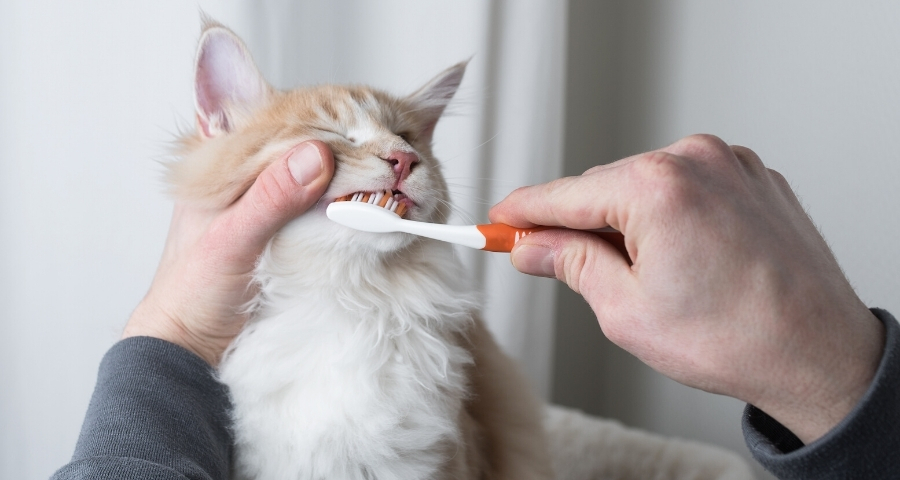 | | Decoding dental health products | | | Whilst many dogs and occasional cats can be gradually trained to have their teeth brushed at home, this just isn’t possible for some pets! As a result, there are many pet dental care products available on the market, which may be able to help.
Generally, the most effective products work by “mechanically cleaning” your pet’s teeth - this is a physical “brushing” action to help disrupt the gooey plaque film (which contains bacteria) that gradually forms on your pet’s teeth. If left to build-up, plaque will gradually harden to tartar (a hard brown “shell” adhered to your pet’s tooth), and will also cause inflammation and infection around the tooth roots, which is known as periodontal disease.
Some dental products also have a chemical additive to help reduce tartar build-up, which can be a useful addition to mechanical cleaning.
More effective products generally have the VOHC (Veterinary Oral Health Council) seal of acceptance on the packaging for controlling both plaque AND tartar. This includes certain prescription veterinary dental dry foods, like Hills t/d, and some dental chews, like Oravet chews (both available at reception). Some water additives or supplements can be useful, but are generally only approved to control plaque levels.
Ensure any chew that you feed to your pet has some “bendiness” to it, as very hard products may break your pet’s teeth. It’s also best to monitor your pet when they are eating these chews, to ensure that they’re safely chewing it up before swallowing.
Whilst raw bones can provide a useful mechanical cleaning effect, they can pose a risk of injury to some pets, such as tooth breakage, gut damage or constipation, so they should be considered with caution. The jury is still out as to whether they are as good idea or can cause more harm than good. If your pet
If you’re unsure of which products would best suit your pet, have a chat with our veterinary team for more specific recommendations! |
|
|
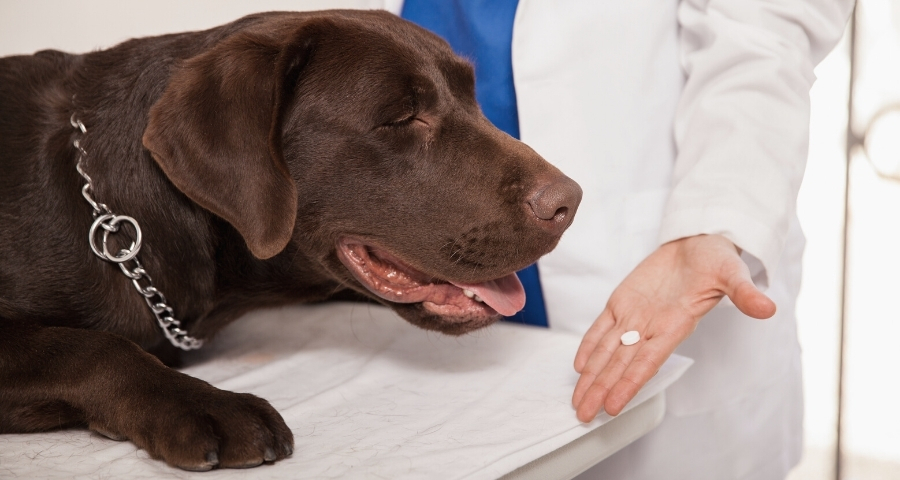 | | No pain, definite gain! | | | If our vets recommend that your pet needs teeth removed, it’s natural to feel a little worried. Therefore, we’d like to answer some common questions that we receive from owners in this situation.
Will my animal be really sore after a tooth extraction?
Rest assured that your animal will be prescribed effective pain relief suited to their particular dental procedure, which should keep their discomfort to a minimum. Pain relief is generally given:
- Before the procedure – in the form of a pre-anaesthetic sedation medication
- During the procedure – we can perform dental nerve blocks to numb extraction sites for several hours
- After the procedure – pets are sent home afterwards with oral pain relief medication
Will my pet be able to eat properly after their teeth have been removed?
Apart from a period of one-to-two weeks post-operation where your pet may need to be restricted to soft food only (to allow their extraction sites to heal), they should be able to eat commercial tinned and/or dry pet food just fine after their extractions. We'll advise you further specific to your pet.
Unlike wild animals, companion cats and dogs don’t need all of their teeth, as we offer them an easy, nutritious diet with relatively little work on their part! Hills t/d is an excellent option that can slow the progression of dental disease and space out further dental needs.
Why can’t we just leave the tooth?
Our vet team will only recommend removal of a tooth if they think the tooth is causing your pet discomfort and cannot be salvaged. Some veterinary dental specialists can recommend root canal and other tooth salvage procedures under specific circumstances. This usually means visiting Sydney. Please let us know if you would like a referral to a veterinary dental specialist.
Pets can be good at masking dental pain, and will generally keep eating unless things get really severe. Many owners are pleasantly surprised when their pet seems even happier after a dental procedure, due to removal of a “hidden” source of chronic pain.
If you have any specific questions or concerns, please ask our friendly team! |
|
|
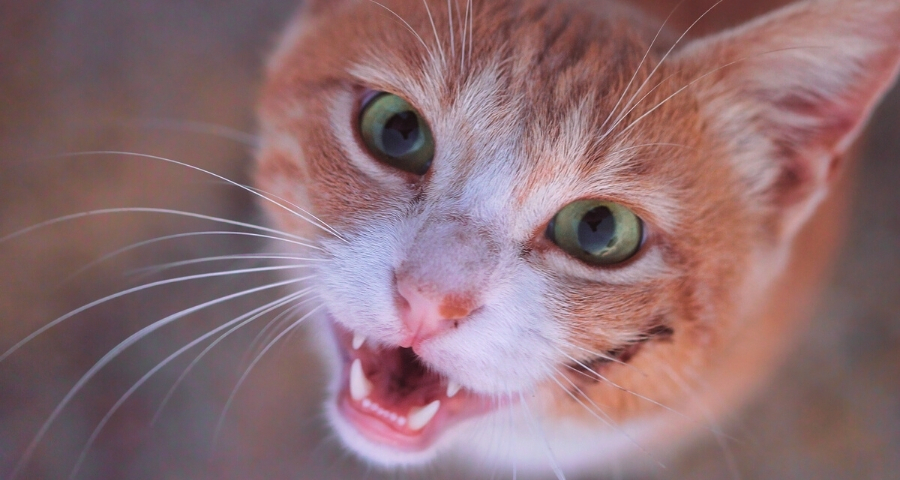 | | Why is dental health important? | | | As your trusted vet team, we want to reassure you that when we recommend a dental clean for your pet, it’s because we think they’ll really benefit from it!
Good dental condition is so important for your pet’s quality of life and their general health.
What is dental disease?
Classic “dental disease” refers to the disease process that occurs when teeth aren’t regularly brushed. It starts with a build-up of plaque - a gooey film containing bacteria - on the surface of your pet’s teeth. If it isn’t cleaned off, plaque then turns to tartar - a hard brown layer stuck firmly to your pet’s teeth. This traps bacteria, which leads to inflammation and infection of the surrounding gum and jaw tissues (periodontal disease), eventually causing permanent damage to teeth.
What does dental disease look like?
Dental disease appears as:
- A yellow or brown accumulation on your pet’s teeth
- Red gum areas (compared to the usual salmon pink colour)
- Discomfort when being touched around the mouth
- Smell from the mouth
- Loose or missing teeth
Why should we prevent periodontal disease?
Periodontal disease causes permanent damage to your pet’s gum tissues, which eventually leads to the loss of affected teeth. The associated inflammation and infection are also painful for your pet, over months to years. If you’ve ever had dental pain, you’ll know just how much this can affect you!
Infection in the mouth can also release bacteria into the bloodstream, affecting the health of distant organs such as the heart, kidneys and liver.
Lastly, if your pet has a clean mouth, it’s going to make any cuddles and licks from them a lot more pleasant (and less smelly!) for you.
For this reason, we highly recommend a health check-up for every pet every 6-12 months, where (among other things) we can check their dental health! And that’s the tooth! |
|
|
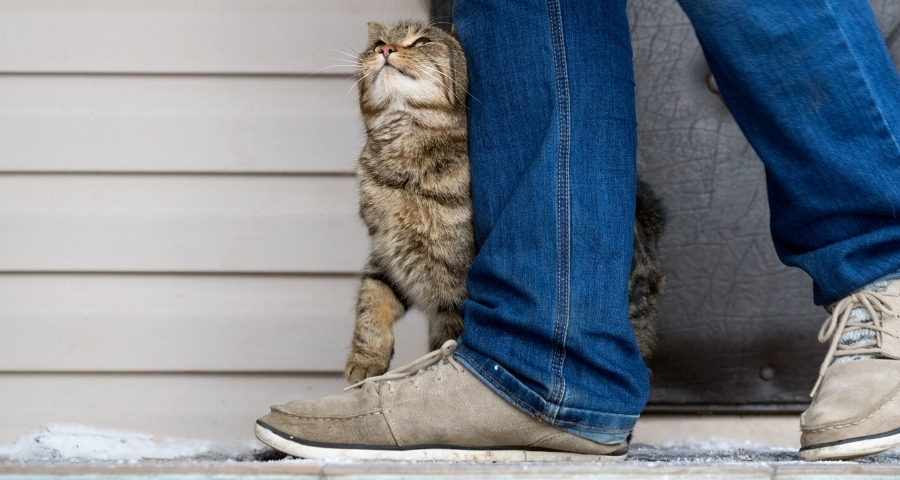 | | Animal News In Brief | | |
Dental Month tip: anaesthesia-free dentistry is harmful and useless
You may have seen offers around for anaesthesia-free dentistry for pets at enticingly low prices, but these procedures are potentially painful and stressful for your pet.
Performing dental examinations and procedures on pets requires vets to get in below the gum line and use dental instruments that need to be very sharp to debride the calculus and plaque from the teeth, which, if your pet is awake, can be painful, distressing and potentially result in injury.
A sufficient routine oral examination must check every single tooth underneath the gum line, as well as the tongue, palate and back of the throat. So, not only is anaesthesia-free dentistry painful, it’s only doing half the job (or even less). Simply removing the calculus from the crown of the tooth does not address where disease can form, it’s merely window dressing and does not tackle any deep-rooted issues. Anaesthesia can be managed to reduce risks and make this a positive and worthwhile experience.
When your pet undergoes anaesthesia-free dentistry, they are physically restrained for a prolonged period of time, unnecessarily provoking traumatic stress and fear. “As the animal is conscious, it will be fully aware of any pain involved in the procedure and this can lead to longer-term anxiety and aversion to being touched around the face and muzzle,” says Dr Cashman from the Australian Veterinary Association’s Dental Society.
So, if you see offers pop up for anaesthesia-free dentistry, put your pet first and say “no thanks”. For your pet’s comfort, safety and wellbeing, routine veterinary dental checks under anaesthetic are recommended. Read more about the dangers of anaesthesia-free dentistry from the RSPCA and Vet Voice.
-----
Feline curious? Learn what kind of relationship you have with your cat
It can be hard to know where you stand with your cat. What might be your idea of a close bond could be totally different to what they’re thinking, which is most likely “feed me, human!” A study from the University of Lincoln in the UK surveyed almost 4,000 cat owners to understand the various types of cat-to-owner relationships. By analysing different human attachment styles and social support theories, the study narrowed down five distinct forms of cat-owner relationships: ‘Open relationship’, ‘Remote association’, ‘Casual relationship’, ‘Co-dependence’ and ‘Friendship’. The university’s animal behavioural specialist, Professor Daniel Mills, surmised that the relationship between cat and owner is a “product of the dynamic between both individuals involved, along with their certain personality features.” Find out what kind of relationship you have with your cat in the university’s free online quiz.
Read more about the study on cat-to-owner relationships here.
-----
Warning: cluster of dog food toxicity cases
Twelve dogs have died recently from liver toxicity by raw meat sourced from Maffra Knackery in Victoria, Australia. In total, 52 cases have been cited of animals falling sick from the meat. The knackery, which also trades as Backmans Meats and Backmans Greyhound Supplies, has now issued a voluntary recall of their raw chopped meat, as Agriculture Victoria issued a state-wide alert. As the worst outbreak of potentially food-related fatality cases in over a decade, calls are being made for stricter pet food standards to avoid this situation ever happening again. If you think your pet may have ingested food from Maffra Knackery, make an appointment. In the meantime, keep an eye on your dog for these symptoms: reduced appetite, increased thirst, vomiting and yellowing around the eyes and gums. If you suspect your pet’s food may be making them ill, tell us! We can do blood tests to check your pet's liver function, as that seems to be the worst affected organ. We can also make reports to PetFAST, a joint safety initiative of the Australian Veterinary Association and the Pet Food Industry Association of Australia. Read more about the outbreak here.
If you have any concerns about your pet, call us today. |
|
|
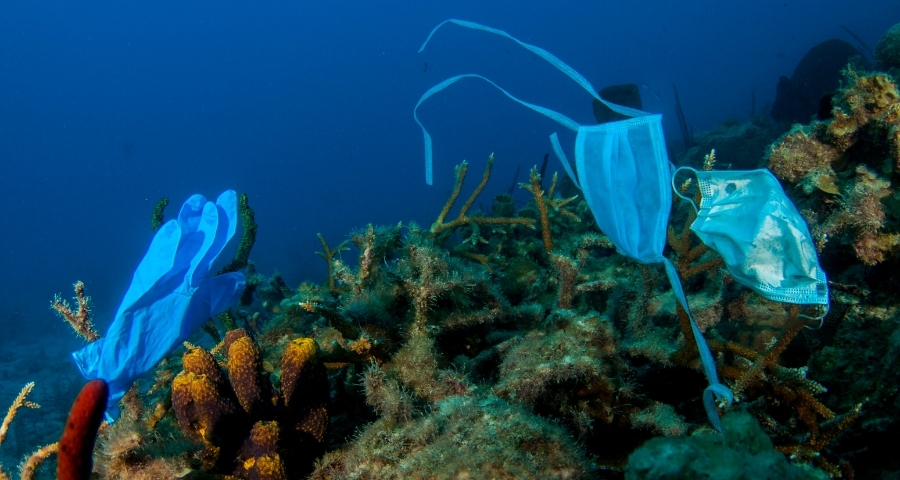 | | The effects of COVID-19 litter on animal life | | | The surge in everyday consumption and disposal of single-use plastics, such as masks and gloves used for individual protection against the COVID-19 virus, has seen animals across the globe affected by pollution to their natural habitats. Ironically, the personal protection products that are designed to keep us safe are actually harming animals around us.
As a recent animal biology research article emphasises, the pollutants from the coronavirus pandemic are “an emerging threat to animals.” According to the article, “all the reported findings of entanglement, entrapment, ingestion, and incorporation of PPE into nests, so far involved single-use products.”
The masks we use day-to-day are leaving our faces and finding their way into rivers, seas, nests and bellies of furry, feathered and scaly friends of all kinds, everywhere. Bats, foxes, hedgehogs, pufferfish, shore crabs, penguins and even octopi, just to name a few, are all in danger of our used PPE.
Dolphins, turtles, and other marine animals can easily choke or suffer from fatal bowel obstructions when they mistake personal protective equipment for food. Turtles full of plastic can end up floating, meaning they cannot feed on their normal foods, getting weaker and skinnier. And not only that, but when plastic breaks down, it releases hazardous chemicals that can exacerbate oceanic acidification. This means that the plastics humans are relying upon for safety are drastically altering the ocean’s ecosystems as we speak - presenting us with a big crisis.
So, what can we do?
- If you work in the medical field and are required to wear disposable PPE, check to see if your local recycling facility can take them.
- Snip the straps of any disposable masks you do discard, just as you should with the plastic rings that come on six-pack cans, and ensure they are disposed of properly.
- Grab yourself some reusable masks. According to the UCL Plastic Waste Innovation Hub, “switching to reusables will result in a 95% reduction in waste,” so this is the most crucial.
- Report PPE littering. The website covidlitter.com collects reports from around the world of animals caught in, ingesting or affected by PPE.
- Where you can, please try and reduce your usage of single-use plastic. From cling wrap to food packaging, and single use plastic bags or even strawers, it all counts.
Let’s do our best to stay safe in this pandemic - and keep our animals and environments safe too. |
|
|
This email contains comments of a general nature only and is not intended to be a substitute for professional veterinary advice. It should not be relied on as the basis for whether you do or don't do anything.
All content © Pet Pack 2020 |
|
|
This email was sent to:
email@example.com
Orange Veterinary Hospital
57 Molong Rd
Orange, NSW 2800
|
|
|
|